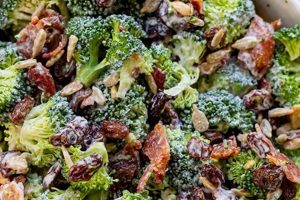This dish typically combines blanched or raw broccoli florets with crispy ramen noodles, often complemented by a sweet and savory dressing. Variations may include other vegetables like carrots, red cabbage, or bell peppers, along with additions such as sunflower seeds, dried cranberries, or mandarin oranges. The ramen noodles are often crushed and toasted, providing a contrasting texture to the broccoli. The dressing often features a base of vinegar, oil, and soy sauce, with added sweetness from sugar or honey.
The appeal of this salad lies in its blend of textures and flavors, offering a satisfying crunch alongside the freshness of the broccoli. It can function as a light meal, a potluck contribution, or a side dish. Its adaptable nature allows for customization based on individual preferences, dietary needs, and available ingredients. This salad also presents an economical option, utilizing readily accessible ingredients. Historically, variations of this dish gained popularity as a budget-friendly and flavorful option, utilizing the versatility of ramen noodles beyond their traditional preparation.
Further exploration of this culinary creation will encompass a detailed examination of ingredient selection, preparation techniques, dressing variations, and suggested serving accompaniments.
Tips for a Superior Broccoli Ramen Salad
Optimizing ingredient preparation and combining flavors are crucial for a successful broccoli ramen salad. The following tips offer guidance for achieving optimal results.
Tip 1: Blanch the Broccoli: Briefly submerging broccoli florets in boiling water, followed by an immediate ice bath, ensures vibrant color and crisp-tender texture, preventing overcooked, mushy broccoli.
Tip 2: Toast the Ramen: Crushing dry ramen noodles and toasting them in a pan with oil or dry roasting in the oven enhances their flavor and creates a desirable crunch.
Tip 3: Tailor the Dressing: While classic dressings often feature vinegar, oil, and soy sauce, consider additions like sesame oil, ginger, garlic, or sriracha for a personalized flavor profile. Adjust sweetness levels based on preference.
Tip 4: Incorporate Textural Variety: Sunflower seeds, slivered almonds, toasted sesame seeds, or chopped peanuts add contrasting textures and enhance the overall sensory experience.
Tip 5: Enhance with Dried Fruit: Dried cranberries, raisins, or chopped apricots introduce sweetness and chewiness, complementing the crunchy noodles and fresh broccoli.
Tip 6: Consider Fresh Herbs: Chopped cilantro, mint, or green onions add a fresh element and elevate the overall flavor complexity.
Tip 7: Balance Sweet and Savory: Achieve a harmonious balance by carefully adjusting the proportions of sweet and savory elements in the dressing and ingredient selection.
Tip 8: Chill Before Serving: Allowing the salad to chill in the refrigerator for at least 30 minutes allows flavors to meld and enhances the refreshing qualities of the dish.
By implementing these strategies, one can elevate the broccoli ramen salad from a simple dish to a culinary highlight, maximizing flavor and texture for an enjoyable dining experience.
With these tips in mind, a deeper understanding of variations and adaptations will be explored in the concluding sections.
1. Fresh Broccoli
Fresh broccoli serves as a crucial foundation in a broccoli salad with ramen noodles, contributing significantly to the dish’s nutritional value, textural appeal, and overall flavor profile. The quality of the broccoli directly impacts the final result. Fresh broccoli offers crisp-tender florets with a vibrant green color, contrasting visually and texturally with the other components. Its slightly sweet, earthy flavor complements the savory notes of the dressing and the toasted ramen noodles. Utilizing fresh, high-quality broccoli ensures optimal nutritional benefits, contributing vitamins, minerals, and fiber to the salad. For instance, substituting frozen or pre-cut broccoli, while convenient, can result in a softer texture and a less vibrant flavor, potentially compromising the overall quality of the salad.
The preparation of fresh broccoli also plays a vital role. Proper blanching techniques briefly immersing the florets in boiling water followed by an immediate ice bath preserve the broccoli’s bright green color and enhance its crisp-tender texture, preventing overcooking. This blanching process also mitigates the strong, sometimes sulfurous, aroma that can develop when broccoli is overcooked. Conversely, using raw broccoli, while offering a different textural experience, might require thinner slicing or chopping to ensure a pleasant bite and prevent it from overpowering the other ingredients.
Selecting and preparing fresh broccoli correctly is essential for a successful broccoli ramen salad. This ingredient not only provides nutritional substance but also contributes significantly to the appealing color, texture, and flavor balance that define the dish. Attention to this key component ensures a satisfying culinary experience and maximizes the health benefits of this popular salad. The choice between blanched or raw broccoli offers opportunities for customization based on individual preferences and desired textural outcomes.
2. Crispy Ramen
Crispy ramen noodles constitute a defining element in the broccoli ramen salad, contributing a distinctive textural contrast and savory dimension. The preparation method significantly influences the final product. Uncooked ramen noodles, typically crushed before preparation, offer a blank canvas for flavor absorption. Common preparation methods include pan-frying or dry-roasting, each impacting the final texture and taste. Pan-frying, usually in oil, creates a richer, more savory flavor profile, while dry-roasting yields a lighter, airier crunch. The absence of added moisture in the dry-roasting method maximizes crispness. Over-toasting, however, can result in burnt noodles, impacting the overall flavor negatively. Consider a specific example: ramen noodles toasted in sesame oil with a sprinkle of onion and garlic powder enhance the savory notes and complement the broccoli and dressing, demonstrating the impact of mindful preparation.
The crispness of the ramen noodles offers a counterpoint to the softer textures of the broccoli and other potential ingredients, such as dried fruit. This textural interplay is crucial for a balanced sensory experience. Imagine biting into a salad where soft broccoli meets a burst of salty, crunchy ramenthe textural contrast elevates the overall enjoyment. Furthermore, the toasted ramen absorbs the flavors of the dressing, acting as a flavor carrier throughout the salad. Without the crispy ramen, the salad risks becoming texturally monotonous, lacking the signature crunch that distinguishes it. This textural element contributes significantly to the salad’s widespread appeal.
Achieving optimal crispness requires careful attention to cooking time and temperature. Whether pan-frying or dry-roasting, close monitoring ensures the noodles achieve the desired texture without burning. Understanding the role of crispy ramen in the overall composition of the broccoli saladits textural contribution, its capacity to absorb flavors, and the impact of its preparation methodallows for a more informed and nuanced approach to creating a truly satisfying dish. The balance of flavors and textures ultimately determines the success of the final product.
3. Flavorful Dressing
The dressing in a broccoli salad with ramen noodles serves as the unifying element, binding the diverse ingredients and influencing the overall flavor profile. A well-crafted dressing elevates the salad beyond a simple combination of components, transforming it into a cohesive and harmonious culinary experience. The balance of sweet, savory, tangy, and umami notes within the dressing dictates the final character of the dish.
- Sweetness
Sweetness, often derived from sugar, honey, or maple syrup, tempers the savory elements and provides a counterpoint to the slight bitterness of the broccoli. The level of sweetness influences the overall balance and can be adjusted to individual preferences. For example, a dressing with honey and rice vinegar offers a milder sweetness compared to one with brown sugar and apple cider vinegar, showcasing the nuanced impact of ingredient choices.
- Acidity
Acidity, introduced through vinegar or citrus juice, brightens the flavor profile and adds a refreshing tang. This element cuts through the richness of the ramen noodles and other potential ingredients, preventing the salad from becoming overly heavy. Rice vinegar contributes a subtle tang, while apple cider vinegar imparts a more pronounced sharpness. Lemon or lime juice provide a citrusy twist, demonstrating the varied impact of acidic components.
- Savory Depth
Savory depth, achieved through ingredients like soy sauce, tamari, or fish sauce, adds a layer of umami and complexity. This element balances the sweetness and acidity, creating a more rounded flavor profile. Soy sauce provides a classic savory foundation, while fish sauce contributes a more pungent, umami-rich note, illustrating the diverse flavor profiles achievable through savory components.
- Aromatic Enhancements
Aromatic enhancements, such as grated ginger, minced garlic, or toasted sesame oil, introduce further complexity and elevate the overall sensory experience. These additions can complement and amplify the other flavor components, creating a more nuanced and layered flavor profile. Toasted sesame oil adds a nutty aroma, while ginger provides a warm, slightly spicy note, demonstrating the impact of aromatic enhancements on the overall composition.
The interplay of these elements within the dressing determines the final character of the broccoli salad with ramen noodles. A harmonious balance of sweetness, acidity, savory depth, and aromatic enhancements creates a cohesive flavor profile that complements the individual ingredients while unifying them into a single, satisfying dish. The dressing acts as the conductor, orchestrating the flavors and ensuring a balanced and enjoyable culinary experience.
4. Textural Contrast
Textural contrast forms a cornerstone of a successful broccoli salad with ramen noodles, elevating it from a simple combination of ingredients to a multi-sensory experience. This interplay of textures adds complexity and interest, engaging the palate beyond basic flavor profiles. The contrast typically stems from the juxtaposition of crisp elements against softer components. The crispy ramen noodles, often toasted or pan-fried, provide the primary source of crunch. This crispness contrasts sharply with the tender, slightly yielding texture of the broccoli florets, whether raw or blanched. This fundamental contrast establishes a foundational textural dynamic.
Further textural complexity can be achieved through the incorporation of additional ingredients. Nuts and seeds, such as sunflower seeds, slivered almonds, or sesame seeds, introduce another layer of crunch, amplifying the contrast and offering varied levels of crispness. Dried fruits, like cranberries or raisins, provide a chewy counterpoint to the crunchy elements and the softer broccoli. Even the dressing can contribute to textural variation; a thicker, creamier dressing offers a contrasting mouthfeel compared to a lighter vinaigrette. Consider, for instance, a salad with crisp ramen, tender broccoli, crunchy sunflower seeds, and chewy cranberriesthe interplay of textures enhances the overall enjoyment, preventing a monotonous experience. Conversely, a salad lacking these textural variations might feel one-dimensional and less satisfying.
Understanding the significance of textural contrast allows for informed choices regarding ingredient selection and preparation methods. Achieving the desired balance requires careful consideration of each component’s textural contribution. The interplay of crisp, tender, chewy, and creamy elements elevates the broccoli salad with ramen noodles, transforming it into a more engaging and satisfying culinary creation. This careful orchestration of textures ultimately distinguishes a well-composed salad from a mere mixture of ingredients.
5. Versatile Ingredients
The adaptability of a broccoli salad recipe with ramen noodles lies in its capacity to accommodate a wide range of ingredients, catering to diverse tastes and dietary preferences. This inherent versatility stems from the neutral foundation provided by the core componentsbroccoli and ramenwhich readily absorb and complement various flavors and textures. This adaptability allows for creative exploration and personalized variations, making the recipe suitable for a wide range of occasions and palates.
- Protein Integration
Protein additions readily enhance the nutritional value and satiety of the salad. Grilled chicken or tofu offer lean protein options, while shrimp or edamame provide alternative sources with distinct flavor profiles. The inclusion of protein transforms the salad into a more complete meal, suitable as a standalone dish rather than a side. For example, adding grilled chicken breast provides a substantial protein boost, while incorporating edamame enhances the protein content while aligning with vegetarian diets. The choice of protein significantly impacts the overall flavor profile and nutritional composition.
- Vegetable Enhancements
The incorporation of additional vegetables expands the nutritional profile and introduces textural and flavor complexity. Shredded carrots offer sweetness and vibrant color, while sliced bell peppers contribute a crisp, slightly sweet taste. Blanched snow peas or snap peas add a delicate crunch, showcasing the diverse textures achievable through vegetable additions. These additions not only diversify the nutritional content but also enhance the visual appeal and overall sensory experience. For instance, adding shredded red cabbage introduces a vibrant color and a subtly peppery flavor, while incorporating julienned carrots offers sweetness and a pleasant crunch.
- Flavorful Accents
Flavorful accents provide opportunities for personalization and creativity. Toasted sesame seeds offer a nutty depth, while dried cranberries contribute a sweet-tart element. Mandarin orange segments introduce a burst of citrusy freshness, contrasting with the savory elements. The choice of these accents allows for customization based on individual preferences and desired flavor profiles. For example, the addition of chopped cilantro provides a fresh, herbaceous note, while incorporating toasted slivered almonds introduces a rich, nutty flavor and a satisfying crunch. These seemingly small additions significantly impact the overall flavor profile.
- Dressing Variations
The dressing serves as a critical component, influencing the overall flavor profile and tying the ingredients together. A creamy dressing based on mayonnaise or Greek yogurt provides a richer, tangier element, while a lighter vinaigrette offers a brighter, more acidic counterpoint. The choice of dressing can significantly alter the final character of the salad, catering to different taste preferences and dietary considerations. For instance, a peanut dressing adds a nutty, savory dimension, while a ginger-soy vinaigrette introduces a tangy, umami-rich flavor. The dressing choice allows for customization and creativity, transforming the overall sensory experience.
The inherent versatility of the broccoli salad with ramen noodles extends beyond its core ingredients, encompassing diverse proteins, vegetables, flavor accents, and dressing variations. This adaptability allows for endless customization, ensuring a satisfying and personalized culinary experience tailored to individual preferences and dietary needs. The ability to seamlessly incorporate diverse ingredients makes this salad a versatile and adaptable dish suitable for various occasions and palates, highlighting its enduring popularity.
Frequently Asked Questions
This section addresses common inquiries regarding broccoli salad with ramen noodles, providing clarity and practical guidance.
Question 1: Can this salad be prepared in advance?
Advance preparation is possible, but specific considerations ensure optimal quality. The dressing and toasted ramen noodles should be added just before serving to maintain the noodles’ crispness and prevent the salad from becoming soggy. The broccoli and other vegetables can be prepared and stored separately ahead of time.
Question 2: What type of ramen noodles is recommended?
While any flavor of ramen noodles can be utilized, the classic chicken or beef flavors are generally preferred for their savory contribution. The flavor packet is typically discarded, as the dressing provides ample seasoning. However, a small portion of the seasoning packet can be incorporated if desired.
Question 3: How can sogginess be prevented?
Sogginess is primarily caused by the dressing softening the ramen noodles and vegetables. To mitigate this, add the dressing immediately before serving. Ensuring the vegetables are thoroughly dried after washing also helps prevent excess moisture.
Question 4: What are suitable substitutions for the dressing ingredients?
Ingredient substitutions offer flexibility based on dietary restrictions or preferences. Apple cider vinegar can be substituted for rice vinegar, and honey or maple syrup can replace sugar. Soy sauce can be replaced with tamari or coconut aminos for gluten-free options.
Question 5: How long can the salad be stored?
When refrigerated without the dressing, the salad can typically be stored for up to three days. Once dressed, it’s best consumed within a few hours to maintain optimal texture and flavor.
Question 6: Can this salad be adapted for different dietary needs?
The recipe’s adaptability extends to various dietary needs. Gluten-free versions can be achieved by using gluten-free tamari or coconut aminos in place of soy sauce and ensuring the ramen noodles are gluten-free. Vegan adaptations can utilize maple syrup or agave nectar as sweeteners and omit any non-vegan ingredients in the dressing.
Careful attention to preparation methods and ingredient selection ensures a satisfying and flavorful broccoli salad with ramen noodles experience. Addressing these frequently asked questions clarifies potential challenges and offers practical solutions for optimizing the final product.
The following section will offer a collection of recipe variations, providing further inspiration and customization options.
Broccoli Salad Recipe with Ramen Noodles
Exploration of this dish reveals a compelling interplay of textures, flavors, and adaptable components. From the crisp-tender broccoli and crunchy ramen noodles to the balanced dressing and versatile additions, each element contributes to the overall culinary experience. Careful preparation techniques, including blanching the broccoli and toasting the ramen, optimize the textural contrast and flavor absorption. The dressing, a crucial unifying element, harmonizes sweet, savory, and tangy notes, while the adaptability of the recipe accommodates diverse dietary preferences and ingredient variations.
This dish represents more than a simple salad; it embodies a culinary synthesis of readily available ingredients transformed into a satisfying and adaptable meal. Its enduring popularity underscores its versatility and the potential for creative exploration within a seemingly simple framework. Continued experimentation with flavor profiles, ingredient combinations, and textural enhancements promises further evolution and enjoyment of this adaptable culinary creation.






